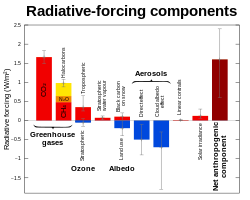Radiative forcing
In climate science, radiative forcing is (loosely) defined as the difference between the incoming radiation energy and the outgoing radiation energy in a given climate system. A positive forcing (more incoming energy) tends to warm the system, while a negative forcing (more outgoing energy) tends to cool it. Possible sources of radiative forcing are changes in insolation (incident solar radiation), or the effects of variations in the amount of radiatively active gases present. Because the Intergovernmental Panel on Climate Change (IPCC) regularly assesses the radiative forcing, it also has a more specific technical definition - see "IPCC usage" section.
Radiation balance
The energy which affects Earth's weather comes from the Sun. The planet and its atmosphere absorb and reflect some of the energy, while long-wave energy is radiated back into space. The balance between absorbed and radiated energy determines the average temperature. The planet is warmer than it would be in the absence of the atmosphere: see greenhouse effect. The carbon dioxide concentration affects the atmospheric energy input; a simplified first-order approximation is:
where C is the CO2 concentration in parts per million by volume and C0 is the reference concentration. ΔF is the change in radiative forcing watts per square meter. (Myhre, et al. 1998.)
The radiation balance can be altered by factors such as intensity of solar energy, reflection by clouds or gases, absorption by various gases or surfaces, and emission of heat by various materials. Any such alteration is a radiative forcing, and causes a new balance to be reached. In the real world this happens continuously as sunlight hits the surface, clouds and aerosols form, the concentrations of atmospheric gases vary, and seasons alter the ground cover.
The relationship between carbon dioxide and radiative forcing is logarithmic so that increased concentrations have a progressively smaller warming effect. Computer models such as those cited by the IPCC include positive and negative feedback mechanisms; the net effect of these feedback mechanisms is to amplify temperature increases CO2, roughly by a factor of two in most models.
IPCC usage

The term “radiative forcing” has been employed in the IPCC Assessments with a specific technical meaning to denote an externally imposed perturbation in the radiative energy budget of the Earth’s climate system, which may lead to changes in climate parameters [1]. The exact definition used is:
- The radiative forcing of the surface-troposphere system due to the perturbation in or the introduction of an agent (say, a change in greenhouse gas concentrations) is the change in net (down minus up) irradiance (solar plus long-wave; in Wm-2) at the tropopause AFTER allowing for stratospheric temperatures to readjust to radiative equilibrium, but with surface and tropospheric temperatures and state held fixed at the unperturbed values. [2]
In the context of climate change, the term forcing is restricted to changes in the radiation balance of the surface-troposphere system imposed by external factors, with no changes in stratospheric dynamics, without any surface and tropospheric feedbacks in operation (i.e., no secondary effects induced because of changes in tropospheric motions or its thermodynamic state), and with no dynamically-induced changes in the amount and distribution of atmospheric water (vapour, liquid, and solid forms).
Related measures
Radiative forcing is intended as a useful way to compare different causes of perturbations in a climate system. Other possible tools can be constructed for the same purpose: for example Shine et al, An alternative to radiative forcing for estimating the relative importance of climate change mechanisms, GEOPHYSICAL RESEARCH LETTERS, 2003 say "...recent experiments indicate that for changes in absorbing aerosols and ozone, the predictive ability of radiative forcing is much worse... we propose an alternative, the 'adjusted troposphere and stratosphere forcing'. We present GCM calculations showing that it is a significantly more reliable predictor of this GCM's surface temperature change than radiative forcing. It is a candidate to supplement radiative forcing as a metric for comparing different mechanisms...". In this quote, the word "predictive" may be confusing: it refers to the ability of the tool to help explain the response, not to the ability of GCMs to forecast climate change.
References
- Myhre et al., New estimates of radiative forcing due to well mixed greenhouse gases, Geophysical Research Letters, Vol 25, No. 14, pp 2715-2718, 1998
See also
External links
- United States National Research Council (2005), Radiative Forcing of Climate Change: Expanding the Concept and Addressing Uncertainties, Board on Atmospheric Sciences and Climate

